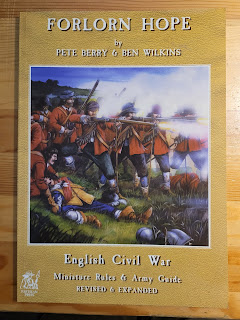Forlorn Hope
I first played a 'formal' wargame at school, with crudely painted Airfix Napoleonics using some one page simple Discovering Wargaming rules. In other words I'm old. A bit set in my ways. As the kidz would say, I am very definitely old skool. The next ruleset to come under the KeepYourPowderDry microscope can very definitely be described as 'old skool'.
Forlorn Hope was written by Pete Berry and Ben Wilkins, Pete's name will appear on quite a few sets of 'ECW' rules over the years (he is also responsible for Baccus 6mm figures). Clearly written by out and out ECW anoraks (in a good way) you will often see these rules described as a 'labour of love'. They are very definitely a 'labour of love' for both the authors, and those who like the game. The game, however, is possibly not to everyone's taste.
My copy is the 3rd Edition, which is still available to purchase new from Caliver Books (or OMM if you find yourself inadvertently on the wrong side of the Atlantic). If you are familiar with Partizan Press volumes you will recognise many of the illustrations, and style of the layout.
Running at 120 pages, if you are an ECW gamer you really should own this book, even if you never play the rules. Of these 120 pages, only about 30 pages are the actual rules themselves. The rest covers historical context; types of soldiers, their armaments and how they were used in battle; some excellent army lists; full colour flag sheets sized for 15mm and 25mm figures; liberally illustrated with line drawings and cartoons; a good, albeit dated, reading list; and four scenarios (Tadcaster, Corbridge, Dunbar, and Wigan Lane).
The rules specify that they can be used for 15mm or 25mm sized figures. I use the movement and firing ranges but simply swap inches to cm. Comes with two quick reference sheets.
Rules for combined pike and shot in regiments of foot can often be convoluted: not so in Forlorn Hope - the ratio of pike and shot determines how they operate and fight.
These are not fast play games: they involve simultaneous movement; command control is fairly basic; lots of morale checks to take; and many charts to consult.
I don't mind a bit of faffing around, on first few plays these rules will seem to have a bit too much faffing around. But with a degree of familiarity this faffing around becomes less of a hindrance and much smoother. This is probably the deal breaker for those brought up on bish-bash-bosh rules.
Despite these, what by modern standards could be described as 'flaws', I love them.
Equipment needed:
- ruler or tape measure (inches)
- D6, average dice, D10, D100














I've also got a copy of the 3rd edition. And they have been sitting gathering dust for some time now which is sad. It was that pike to shot ratio that first intrigued me about the rules as it seemed to offer something other rulesets didn't. Alas, single figure casualty accounting is an idea fallen out of favour (I want my figures on the table) but the idea of rallying figures back to the unit was also one I liked. Some good ideas but too many plus and minus factors for doing most things for me.
ReplyDeleteAs with all things prescribed in rule books - base sizes, casualty removal, I plough my own furrow (casualty markers).
DeleteCor, that 3rd edition cover always inspired me! I played a lot of 1st Edition FH back in my Sealed Knot days (the original orange cover) and always enjoyed the games with my old 'Blew Regiment' mates. I do agree with Dex above that I would find them a bit 'fussy' these days, but great memories.
ReplyDeleteAgreed a fab cover. I'm still on the lookout for a balance of fussy and bish-bash-bosh.
Delete